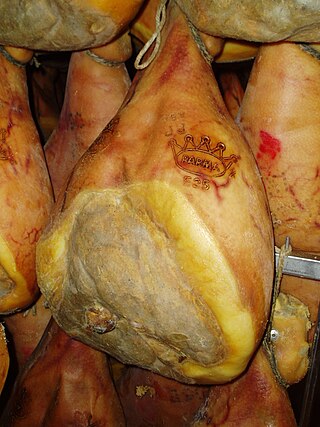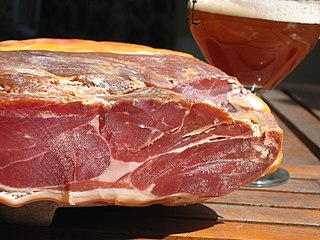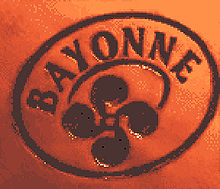
Ham is pork from a leg cut that has been preserved by wet or dry curing, with or without smoking. As a processed meat, the term "ham" includes both whole cuts of meat and ones that have been mechanically formed.

Salting is the preservation of food with dry edible salt. It is related to pickling in general and more specifically to brining also known as fermenting and is one form of curing. It is one of the oldest methods of preserving food, and two historically significant salt-cured foods are salted fish and salt-cured meat. Vegetables such as runner beans and cabbage are also often preserved in this manner.

Prosciutto crudo, in English often shortened to prosciutto, is uncooked, unsmoked, and dry-cured ham. Prosciutto crudo is usually served thinly sliced.

Bresaola is air-dried, salted beef that has been aged two or three months until it becomes hard and turns a dark red, almost purple color. It is made from top (inside) round, and it is lean and tender, with a sweet, musty smell. It originated in Valtellina, a valley in the Alps of northern Italy's Lombardy region.

Pancetta is a salt-cured pork belly meat, product in a category known as salume. In Italy, it is often used to add depth to soups and pastas.

Jamón is a kind of dry-cured ham produced in Spain. It is one of the most globally recognized food items of Spanish cuisine. It is also regularly a component of tapas.

Charcuterie is a French term for a branch of cooking devoted to prepared meat products, such as bacon, ham, sausage, terrines, galantines, ballotines, pâtés, and confit, primarily from pork.

Jamón ibérico, "Iberian ham," is a variety of jamón or presunto, a type of cured leg of pork produced in Spain and Portugal.

In Spanish, cecina is meat that has been salted and dried by means of air, sun or smoke. The word comes from the Latin siccus (dry), via Vulgar Latin (caro) *siccīna, "dry (meat)".
Elenski but is a dry-cured ham from the town of Elena, in northern Bulgaria, and a popular delicacy throughout the country. The meat has a specific taste and can be preserved in the course of several years, owing much to the special process of making and the climatic conditions of the part of Stara Planina where Elena is located.
Leonese cuisine is a sub category of Spanish food that is considered to be very exotic and caloric.

Pig slaughter is the work of slaughtering domestic pigs to obtain pig meat (pork). It regularly happens as part of traditional and intensive pig farming. which is both a common economic activity as well as a traditional feast in some European and Asian countries.

Speck Alto Adige PGI is a dry-cured, lightly smoked ham produced in South Tyrol, northern Italy. Parts of its production are regulated by the European Union under the protected geographical indication (PGI) status.

Jinhua ham is a type of specialty dry-cured ham named after the city of Jinhua, where it is produced, in Zhejiang province, China. The ham is used in Chinese cuisines to flavor stewed and braised foods as well as for making the stocks and broths of many Chinese soups. The ham was awarded first prize in the 1915 Panama International Merchandise Exhibition.

Sausages and cured meats are widely consumed in Switzerland. Meat in general is consumed on a daily basis, pork being particularly ubiquitous in Swiss cuisine. Preserving meat by smoking it or by adding salt has been done for millennia in Switzerland.

The Jambon sec des Ardennes is the collective certification mark for dry-cured hams from the French department of the Ardennes, made from pigs' legs purchased from local farmers and processed by salting, drying and aging.

















